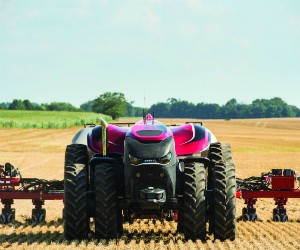Farming has always been about applied technology, from the first wooden tools to monster machinery. Today’s technology is digital and robotic and is in the process of transforming the practice of agriculture—and agricultural meetings.
“The technology revolution that is sweeping agriculture isn’t just an opportunity for farmers to be more efficient and more productive,” said Matt Jungmann, who directs the annual Farm Progress Show, one of the largest agricultural events in North America. “The growing focus on technology makes for new opportunities for planners, too.
"In 1956, the newest technology was all about making farm equipment bigger and more efficient. In 2016, we launched an agricultural data conference because that’s where exhibitors and farming attendees are putting their money," he added.
Farm Progress is also reinventing its own technology capabilities. In-field demonstrations are still the heart of the exhibitor program, but almost every exhibitor incorporates some degree of wireless technology, which means growing bandwidth needs.
The three-day show builds and takes down power generation and data distribution networks that could run a midsize city at its alternating sites near Boone, Iowa, and Decatur, Ill.
It’s not just hands-on outdoor ag shows that are growing. In Omaha, Neb., agriculture is the No. 2 event sector after sports. Groups ranging from the American Association of Bovine Practitioners, veterinarians who specialize in cattle, to the Farmers Business Network, whose Farmer2Farmer show focuses on the intersection of business and technology in agriculture, keep local facilities busy.
Most ag events are smallish, with 450 to 600 attendees, said Mark Rath, sales director for Visit Omaha. Ag is primarily a drive-in market, which gives Omaha and other regional hubs an enormous advantage.
Farm Progress used that same drive market proximity to become the nation’s largest outdoor farm event. With 160,000 attendees yearly, it sits atop Trade Show News Network’s list of the largest tradeshows with another ag event, Husker Harvest Days.
Nearly all attendees, 95 percent, farm, while 92 percent of them produce corn and most harvest three or four crops per year. And few of those attendees match urban misconceptions of farmers as aging country boys who are more at home driving tractors than checking email.
New Farmer, New Consumer, New Age
The average U.S. farmer is about 58 years old, according to the Bureau of Labor Statistics, but ag shows are crowded with farmers in their 20s and 30s.
“Statistics are weighted heavily to the older end because land is owned by the last generation, and farmland ownership is where the age number comes from,” Jungmann said. “Official statistics don’t reflect the 20- and 30-something generation that is actually working the land today.
“They grew up with digital technology and they understand that when a technology allows you to farm every square foot of a field differently, it changes the world,” he added.
Never mind that 75 percent of startup investments in 2015 went to three states: California, New York and Massachusetts. Or that most farming is done in flyover country, that vast expanse of terrain between the East and West coasts.
A growing number of companies and entrepreneurs are seeing opportunity in the Midwest and setting up shop closer to both their tech-savvy young farm market and their tech-savvy young workforce.
Lincoln, Neb., alone has more than 100 tech startups. Kansas City, Kan., and Kansas City, Mo.; St. Louis; Des Moines, Iowa; Omaha, Neb.; and other regional hubs are all growing their own crops of tech and ag tech startups with solid academic support from agricultural research powerhouses like Purdue.
Commentators are even talking about a “Silicon Prairie” that is luring talent—and investment dollars—from Silicon Valley. Washington, D.C.-based venture capital firm Revolution is putting nearly $1 billion into tech startups between the coasts. In the Midwest, that means ag tech startups.
It’s part of $10.1 billion invested in agricultural/food startups in 2017, a 29 percent increase over 2016, according to the AgriFood Tech Investing Report. Investments in agricultural biotech fell 11 percent, while investments in novel farming tech surged 233 percent.
That novel tech is increasingly driven petabytes of data from every field.
Some of that $10.1 billion in new investment is driven by young innovators in farming. And much of it driven by farmers responding to changing consumer expectations.
Paying attention to farms and farming is becoming trendy as more people move to eating healthier, more locally and with less processed foods. A decade ago, organic food was a specialty item ignored by most consumers, retailers and farmers. Today, organic is the hottest seller among all the produce categories tracked by the United Fresh Produce Association.
Consumers bought $1.2 billion in organic produce during the fourth quarter of 2017, an 8.1 percent increase over 2016. It’s no surprise that retailers from Walmart to Whole Foods tout their organic products. Or that farmers are shifting their own focus to provide it.
From Concrete to Digital
Once upon a time, maybe a decade ago, ag shows were about equipment. Big equipment. When exhibitors are showing off combines that weigh in at 60 tons, exhibition space either has to be outdoors, which is how the Farm Progress Show handles it, or exhibit halls need serious structural components.
Displays and demonstrations of Big Iron are still a major component of many ag shows, but the real growth is at the other end of the size scale. The self-driving farm equipment guided by GPS that was featured in the 2014 science fiction epic Interstellar is almost ordinary today.
GPS navigation has become standard for tractors, combines and other farm vehicles. Humans still sit at the controls on most farms, but farm equipment maker Case IH unveiled the first autonomous tractor in 2016.
Self-driving cars grab the headlines, but self-driving farm equipment will likely have a more immediate economic impact.
Developments in agricultural tech are also driving technology capabilities in the meetings industry.
In Omaha, CenturyLink Center was built to meet the needs of agricultural exhibitors with oversized farm equipment. The growing demand is not for more physically robust exhibit space, but for more bandwidth to support skyrocketing data needs for the latest generations of technology products and solutions.
“This creates increased demands on our building’s data network and Internet connectivity,” said Kevin Raymond, vice president of operations and technology for MECA, the city Metropolitan Entertainment & Convention Authority. “Ag show technology requirements continue to increase.
"Our facility offers 10 gigabit Internet data distributed throughout," he added.
"We also have installed a multicarrier cellular distributed antenna system, or DAS, with includes Verizon, AT&T and T-Mobile," he added. "The DAS boosts cellular strength and capabilities for large-scale systems such as GPS, which we see often with new ag equipment.”
There is no sign that bandwidth demand will slow any time soon, Raymond added. Not only are ag products moving away from bigger-is-better hardware, but vendors are also migrating away from earlier generations of hardwired products. The push today is to develop systems geared for wireless solutions, be it Wi-Fi or cellular.
When it comes to managing farm crops or animals, a smartphone and always-on connections are as essential as a shovel and tractor repair skills were in past generations.






